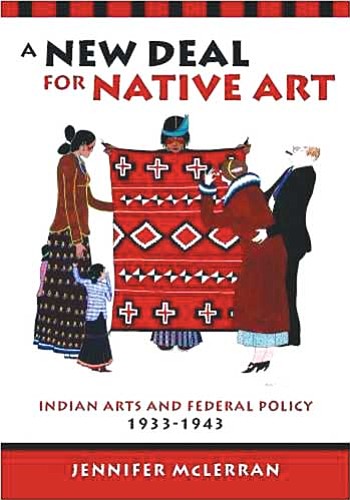Local author explores government influence on Native art
FLAGSTAFF, Ariz. - A difficult economic era in American history that positively affected Native American art is explored in a new book by a Northern Arizona University professor.
A New Deal for Native Art: Indian Arts and Federal Policy 1933-1943, by Jennifer McLerran, an assistant professor of art history at NAU, examines how the U.S. government influenced Native American art production during the New Deal economic reform programs.
The New Deal was the name President Franklin D. Roosevelt gave to a package of economic programs he initiated between 1933 and 1935 with the goal
of helping the unemployed and promoting financial recovery during the Great Depression.
"The New Deal programs had wide and significant impact on Native artwork, but little is known about them," McLerran says. "It's important for people working in the field today to know about past models that can be adapted to current needs."
In this first book to address the ways the New Deal policy advanced Native art forms, McLerran cites a number of successful Native-run arts and crafts cooperatives still in existence and presents case studies that demonstrate the revived success of selling Native artwork.
McLerran, who is also a curator at the Museum of Northern Arizona, describes the federal policies that sought to generate an upscale market with a "demand for high quality" Native American arts and crafts.
The New Deal set out to ensure that arts and crafts designated as "Native" were in fact created by Native Americans and made with real silver, gold, stones and gems.
"Government agencies had targeted tourism to boost the economy, but that resulted in a tourist market of low-quality Native American crafts and souvenirs that was degrading the 20th century Native American art forms," McLerran says. "The goal of New Deal Native art programs was to stimulate tourism and high-quality arts and crafts."
She says stimulating the creation and market for quality work was vital because low-quality products would not provide sufficient income for Native communities.
She argues for similar support to ease the economic tension in today's market and explains why it is important to view Native art as a "commodity" in national political trends and reform efforts.
The Department of the Interior's Indian Arts and Crafts Board, a federal agency that provides marketing assistance and protections to Native artists, formed during the New Deal, has played an important role in providing these services.
"However, it has been chronically underfunded, so its effectiveness has been limited," she says.
McLerran notes that most Native arts and crafts commonly exhibited in museums today are forms that show little non-Native influence, because they are presumed to represent "the purest expressions of their respective cultures, and because they were presumably produced for use by members of their makers' communities."
She suggests it is time to acknowledge the Native artwork created for the marketplace.
"To ignore these forms and the influences that shaped them is to deny Native people status as active agents of change and innovation," says McLerran, who is now researching the role Museum of Northern Arizona co-founder Mary-Russell Ferrell Colton played in the New Deal Native arts promotion and development.
"She had a major influence on the development of Hopi overlay jewelry, a product of that era," McLerran says. "She also played a major role in efforts to improve the quality of Navajo weaving through promotion of vegetal dyes and efforts to revive the use of Churro wool."
A New Deal in Native Art was published by the University of Arizona Press.
SUBMIT FEEDBACK
Click Below to:




